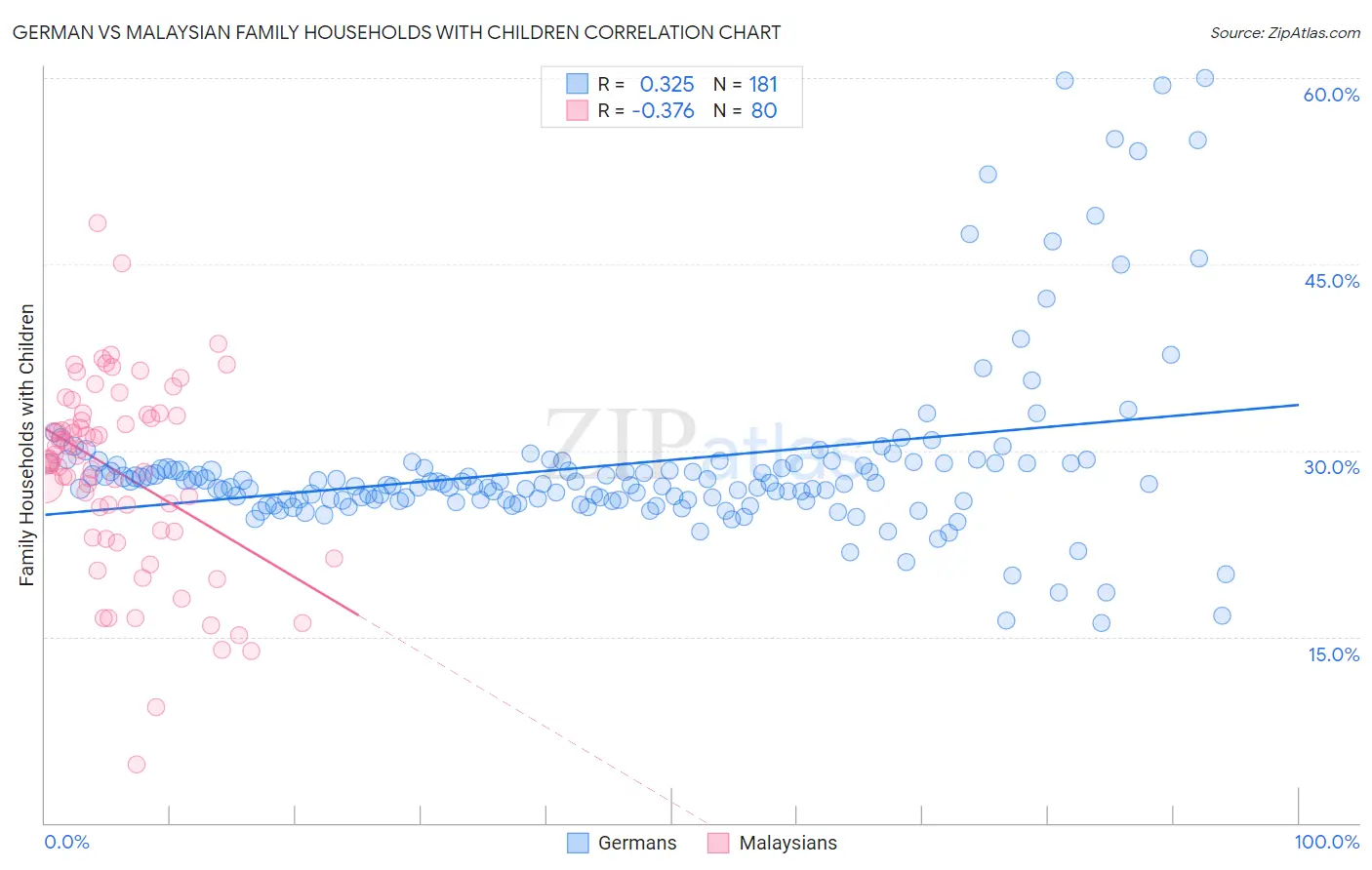German vs Malaysian Family Households with Children
COMPARE
German
Malaysian
Family Households with Children
Family Households with Children Comparison
Germans
Malaysians
27.1%
FAMILY HOUSEHOLDS WITH CHILDREN
8.7/ 100
METRIC RATING
224th/ 347
METRIC RANK
29.8%
FAMILY HOUSEHOLDS WITH CHILDREN
100.0/ 100
METRIC RATING
22nd/ 347
METRIC RANK
German vs Malaysian Family Households with Children Correlation Chart
The statistical analysis conducted on geographies consisting of 579,972,630 people shows a mild positive correlation between the proportion of Germans and percentage of family households with children in the United States with a correlation coefficient (R) of 0.325 and weighted average of 27.1%. Similarly, the statistical analysis conducted on geographies consisting of 225,942,308 people shows a mild negative correlation between the proportion of Malaysians and percentage of family households with children in the United States with a correlation coefficient (R) of -0.376 and weighted average of 29.8%, a difference of 10.1%.

Family Households with Children Correlation Summary
| Measurement | German | Malaysian |
| Minimum | 16.1% | 4.8% |
| Maximum | 60.0% | 48.3% |
| Range | 43.9% | 43.6% |
| Mean | 28.8% | 28.2% |
| Median | 27.3% | 29.4% |
| Interquartile 25% (IQ1) | 26.0% | 23.6% |
| Interquartile 75% (IQ3) | 29.0% | 32.8% |
| Interquartile Range (IQR) | 3.0% | 9.3% |
| Standard Deviation (Sample) | 7.2% | 7.7% |
| Standard Deviation (Population) | 7.2% | 7.7% |
Similar Demographics by Family Households with Children
Demographics Similar to Germans by Family Households with Children
In terms of family households with children, the demographic groups most similar to Germans are Pima (27.1%, a difference of 0.030%), Paraguayan (27.1%, a difference of 0.050%), New Zealander (27.1%, a difference of 0.060%), Austrian (27.1%, a difference of 0.080%), and Canadian (27.1%, a difference of 0.090%).
| Demographics | Rating | Rank | Family Households with Children |
| U.S. Virgin Islanders | 12.1 /100 | #217 | Poor 27.1% |
| Greeks | 11.4 /100 | #218 | Poor 27.1% |
| Immigrants | Japan | 10.7 /100 | #219 | Poor 27.1% |
| Austrians | 9.9 /100 | #220 | Tragic 27.1% |
| New Zealanders | 9.6 /100 | #221 | Tragic 27.1% |
| Paraguayans | 9.4 /100 | #222 | Tragic 27.1% |
| Pima | 9.2 /100 | #223 | Tragic 27.1% |
| Germans | 8.7 /100 | #224 | Tragic 27.1% |
| Canadians | 7.5 /100 | #225 | Tragic 27.1% |
| Czechoslovakians | 6.6 /100 | #226 | Tragic 27.0% |
| Tsimshian | 6.6 /100 | #227 | Tragic 27.0% |
| Scottish | 6.5 /100 | #228 | Tragic 27.0% |
| Immigrants | Caribbean | 6.3 /100 | #229 | Tragic 27.0% |
| Bulgarians | 5.8 /100 | #230 | Tragic 27.0% |
| Luxembourgers | 5.5 /100 | #231 | Tragic 27.0% |
Demographics Similar to Malaysians by Family Households with Children
In terms of family households with children, the demographic groups most similar to Malaysians are Immigrants from Laos (29.8%, a difference of 0.030%), Immigrants from El Salvador (29.8%, a difference of 0.080%), Alaska Native (29.9%, a difference of 0.11%), Salvadoran (29.9%, a difference of 0.14%), and Mexican American Indian (29.7%, a difference of 0.27%).
| Demographics | Rating | Rank | Family Households with Children |
| Immigrants | South Central Asia | 100.0 /100 | #15 | Exceptional 30.0% |
| Immigrants | Afghanistan | 100.0 /100 | #16 | Exceptional 30.0% |
| Hispanics or Latinos | 100.0 /100 | #17 | Exceptional 29.9% |
| Salvadorans | 100.0 /100 | #18 | Exceptional 29.9% |
| Alaska Natives | 100.0 /100 | #19 | Exceptional 29.9% |
| Immigrants | El Salvador | 100.0 /100 | #20 | Exceptional 29.8% |
| Immigrants | Laos | 100.0 /100 | #21 | Exceptional 29.8% |
| Malaysians | 100.0 /100 | #22 | Exceptional 29.8% |
| Mexican American Indians | 100.0 /100 | #23 | Exceptional 29.7% |
| Guamanians/Chamorros | 100.0 /100 | #24 | Exceptional 29.7% |
| Immigrants | Latin America | 100.0 /100 | #25 | Exceptional 29.7% |
| Sri Lankans | 100.0 /100 | #26 | Exceptional 29.5% |
| Immigrants | Vietnam | 100.0 /100 | #27 | Exceptional 29.5% |
| Samoans | 100.0 /100 | #28 | Exceptional 29.5% |
| Bolivians | 100.0 /100 | #29 | Exceptional 29.5% |